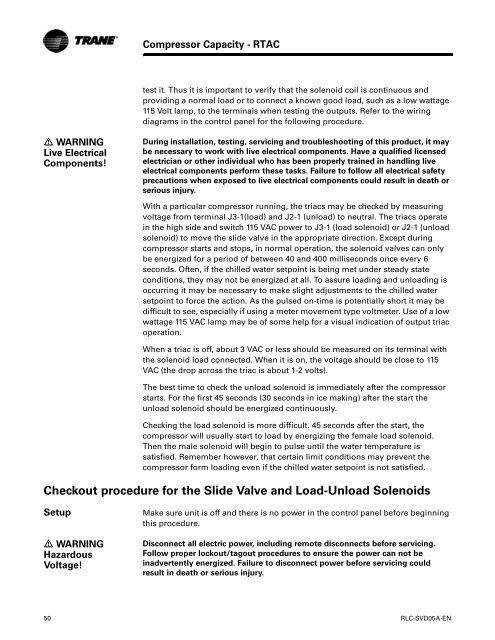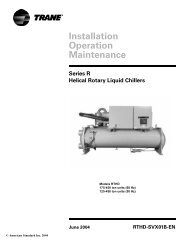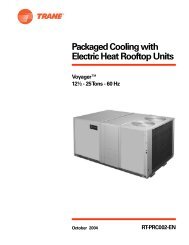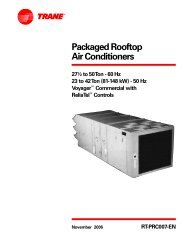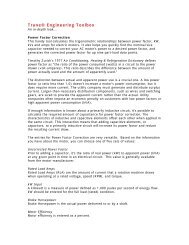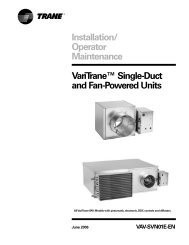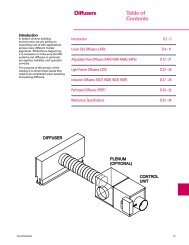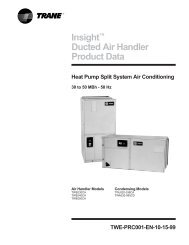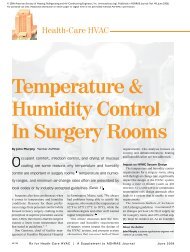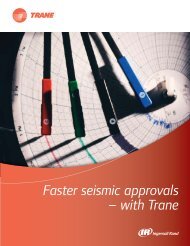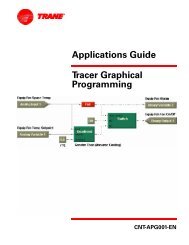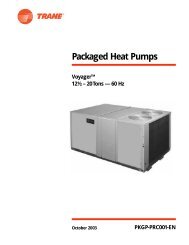RTHD and RTAC - Trane
RTHD and RTAC - Trane
RTHD and RTAC - Trane
You also want an ePaper? Increase the reach of your titles
YUMPU automatically turns print PDFs into web optimized ePapers that Google loves.
� WARNING<br />
Live Electrical<br />
Components!<br />
Compressor Capacity - <strong>RTAC</strong><br />
test it. Thus it is important to verify that the solenoid coil is continuous <strong>and</strong><br />
providing a normal load or to connect a known good load, such as a low wattage<br />
115 Volt lamp, to the terminals when testing the outputs. Refer to the wiring<br />
diagrams in the control panel for the following procedure.<br />
During installation, testing, servicing <strong>and</strong> troubleshooting of this product, it may<br />
be necessary to work with live electrical components. Have a qualified licensed<br />
electrician or other individual who has been properly trained in h<strong>and</strong>ling live<br />
electrical components perform these tasks. Failure to follow all electrical safety<br />
precautions when exposed to live electrical components could result in death or<br />
serious injury.<br />
With a particular compressor running, the triacs may be checked by measuring<br />
voltage from terminal J3-1(load) <strong>and</strong> J2-1 (unload) to neutral. The triacs operate<br />
in the high side <strong>and</strong> switch 115 VAC power to J3-1 (load solenoid) or J2-1 (unload<br />
solenoid) to move the slide valve in the appropriate direction. Except during<br />
compressor starts <strong>and</strong> stops, in normal operation, the solenoid valves can only<br />
be energized for a period of between 40 <strong>and</strong> 400 milliseconds once every 6<br />
seconds. Often, if the chilled water setpoint is being met under steady state<br />
conditions, they may not be energized at all. To assure loading <strong>and</strong> unloading is<br />
occurring it may be necessary to make slight adjustments to the chilled water<br />
setpoint to force the action. As the pulsed on-time is potentially short it may be<br />
difficult to see, especially if using a meter movement type voltmeter. Use of a low<br />
wattage 115 VAC lamp may be of some help for a visual indication of output triac<br />
operation.<br />
When a triac is off, about 3 VAC or less should be measured on its terminal with<br />
the solenoid load connected. When it is on, the voltage should be close to 115<br />
VAC (the drop across the triac is about 1-2 volts).<br />
The best time to check the unload solenoid is immediately after the compressor<br />
starts. For the first 45 seconds (30 seconds in ice making) after the start the<br />
unload solenoid should be energized continuously.<br />
Checking the load solenoid is more difficult. 45 seconds after the start, the<br />
compressor will usually start to load by energizing the female load solenoid.<br />
Then the male solenoid will begin to pulse until the water temperature is<br />
satisfied. Remember however, that certain limit conditions may prevent the<br />
compressor form loading even if the chilled water setpoint is not satisfied.<br />
Checkout procedure for the Slide Valve <strong>and</strong> Load-Unload Solenoids<br />
Setup Make sure unit is off <strong>and</strong> there is no power in the control panel before beginning<br />
this procedure.<br />
� WARNING<br />
Hazardous<br />
Voltage!<br />
Disconnect all electric power, including remote disconnects before servicing.<br />
Follow proper lockout/tagout procedures to ensure the power can not be<br />
inadvertently energized. Failure to disconnect power before servicing could<br />
result in death or serious injury.<br />
50 RLC-SVD05A-EN


